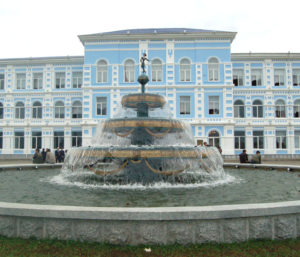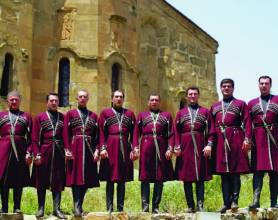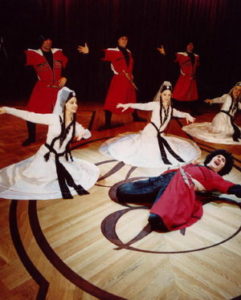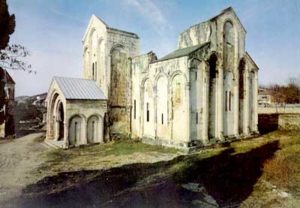Receive our newsletter
Your e-mail address is only used to send you our newsletter and information about the activities of Strasbourg Europe. You can always use the unsubscribe link included in the newsletter.
 Georgia has a long history that spans 3,000 years. Inhabited since the Palaeolithic period, Georgia was divided into two regions between the sixth and the fourth centuries BC: Colchis to the west (western Georgia today), the mythical land of the Golden Fleece, and Iberia to the east (eastern Georgia). A strategic crossroads between East and West, Georgia was frequently invaded by enemy armies. It always knew how to keep its independence from the Arabs, Mongols and Turks, but could not resist colonisation by the Russian forces, whose invasion violated the Treaty of Guiorguievsk signed between Georgia and Russia in 1783. This treaty provided for a Russian military protectorate over Georgia, while ensuring the autonomy of the Georgian kingdom. In reality, however, Georgia was simply integrated into the Russian Empire. It regained its independence in 1918.
Georgia has a long history that spans 3,000 years. Inhabited since the Palaeolithic period, Georgia was divided into two regions between the sixth and the fourth centuries BC: Colchis to the west (western Georgia today), the mythical land of the Golden Fleece, and Iberia to the east (eastern Georgia). A strategic crossroads between East and West, Georgia was frequently invaded by enemy armies. It always knew how to keep its independence from the Arabs, Mongols and Turks, but could not resist colonisation by the Russian forces, whose invasion violated the Treaty of Guiorguievsk signed between Georgia and Russia in 1783. This treaty provided for a Russian military protectorate over Georgia, while ensuring the autonomy of the Georgian kingdom. In reality, however, Georgia was simply integrated into the Russian Empire. It regained its independence in 1918.
Georgian Polyphonic Singing
On May 18, 2001 UNESCO proclaimed the Georgian Polyphonic Singing as a Masterpiece of the Oral and Intangible Heritage of Humanity.
Polyphonic singing is a popular and secular tradition that plays a part in all the activities of daily life, from work songs, to songs of healing, to Christmas carols. The three types of Georgian polyphony are sung in three different regions. Georgian polyphony is astonishingly original and beautiful, with many different forms and genres. There are three types of polyphony: complex polyphony, very common in Svanetia; polyphonic dialogue over a bass background, prevalent in Kakheti in eastern Georgia; and contrasted polyphony with three partially improvised parts, found in the western part of the country.
© Tbilisi State Conservatoire

Traditional dances
Georgian traditional dances are an ancient tradition. Although repeatedly invaded by the Persians, Mongols, Ottomans and Russians, Georgia has preserved its cultural identity. The rhythmic music for these dances is played with the dohol (doli), a two-skinned drum played with a stick and both hands.
Moreover, the multiple invasions helped to forge a unique musical culture, like the dance lezginka. Although shared by the peoples of the Caucasus, each country puts its own unique spin on the lezginka. This dance can be performed solo, in couples, or in groups. The men dance very fast, unlike the women, who almost appears to be floating above the ground, so that the couple will never touch.
It is likely that some of these dances have pagan roots. The festive aspect of Georgian culture has enabled the dancing tradition to be passed down over the centuries. Every occasion is an excuse to dance.
Picture: dancers © http://www.lezginka.net
Architecture

Since the 4th century, Georgian culture has been based on the Christian faith. The country has always resisted several invasions over the centuries, partially thanks to its architecture and fortifications. The ancient fortified churches are altogether unique, especially the Bagrati Cathedral, the Mtskheta Monument, and the Haut Svanétie Fortress, which can be found on the UNESCO World Heritage List.
Photo: Bagrati Catheral, World Heritage © Georgian Parliament
Your e-mail address is only used to send you our newsletter and information about the activities of Strasbourg Europe. You can always use the unsubscribe link included in the newsletter.
Information Center
on the European Institutions (CIIE)
Europe Direct Information Center
All rights reserved to the CIIE
Non-profit organization
Mailing address
1 allée Kastner
67000 Strasbourg
France
Visitors entrance
8 rue Boecklin
67000 Strasbourg
France
To provide the best experiences, we use technologies such as cookies to store and/or access device information. Consenting to these technologies will allow us to process data such as browsing behavior or unique IDs on this site. Failure to consent or withdrawing consent may adversely affect certain features and functions.
Europe Direct network
The CIIE team
Contact information and opening hours
Lieu d’Europe
The CIIE offices
Contact us
CIIE’s Documentation Centre & Publications
School presentations & Activities
Borrowing of learning material
Activities for the general public
Institutions of the European Union in Strasbourg
Institutions Under the Authority of the Council of Europe
Other European Organisations in Strasbourg
Sessions of the European institutions in Strasbourg
Visiting the institutions
Map of the European district of Strasbourg
Institutions in Strasbourg in photos
Discover artistic Europe
National holidays of the member states of the Council of Europe